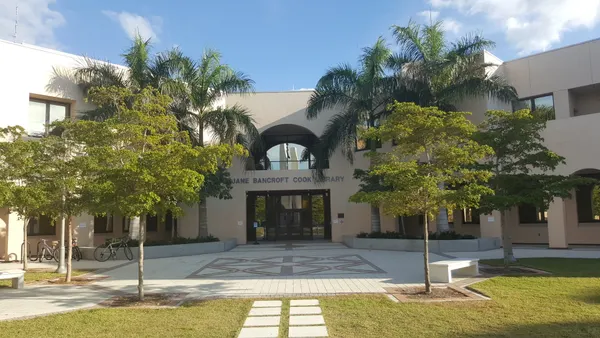Across higher ed, the financial squeeze is tightening. Between shrinking enrollment and uncertain funding, colleges and universities are scrambling to deliver value with far less cash. Every purchase, from lab beakers to toner cartridges, now faces intense scrutiny. After all, one way to uncover excess spending is to identify blind spots and inefficiencies in how organizations buy.
That drive for savings puts procurement teams squarely in the hot seat. Seven in ten procurement leaders rank cost management as their most critical capability today and for the years ahead, according to Economist Impact. Yet decentralized purchasing, patchwork systems, and limited spend visibility continue to drain institutional resources.
Savvy institutions are flipping that script, moving from reactive penny-pinching to proactive value creation by consolidating spend, leveraging supplier partnerships, and centralizing purchasing oversight.
From reactive buying to proactive value creation
Financial uncertainty now dominates the higher ed landscape. To navigate it successfully, universities must shift from tactical price checks to total-value management, leveraging lessons from other industries that have successfully implemented AI-powered automations to boost efficiencies and cut costs, University Business reports. It’s the difference between playing defense and offense—both matter, but one drives wins.
This strategic transformation requires three foundational moves: gaining real-time visibility into campuswide spending patterns, establishing centralized oversight without bureaucratic friction, and building supplier relationships that deliver value beyond the initial purchase price.
“Reducing spend is important, but increasing value matters more,” shares Rosie Grigsby, senior sales manager for higher education at Amazon Business. “When you’re looking at things only from a price perspective, you’re missing out on other value aspects like quality, lifecycle, support, training, and more,” she explains. “When thinking about total value, I’m thinking about how a supplier is enhancing student experiences while giving university employees time back through efficiencies.”
To make that possible, procurement leaders would be wise to prioritize the visibility problem: You can’t optimize what you can’t see. Gaining visibility into campuswide spending starts with breaking down the silos that keep procurement teams in the dark.
Visibility and control: Centralizing spend without adding bureaucracy
Imagine navigating unfamiliar terrain with a GPS that only shows you one street at a time. When departments buy in silos, institutions lose their ability to see the bigger picture, eroding spend leverage, killing negotiating power, and complicating compliance. Each isolated purchase decision chips away at potential savings and strategic control.
Consider the cascading impact: With fragmented purchasing, universities could be paying different prices for the same product across departments, missing significant volume discounts, and discovering duplicate software licenses only during audits. Worse yet, audits could reveal policy violations that were invisible until it was too late.
Unsurprisingly, research by the IBM Center for the Business of Government shows that centralized procurement correlates with higher savings, efficiencies, and compliance. Even so, many procurement leaders struggle with organization-wide visibility.
The solution isn’t building a bureaucratic fortress around every purchase decision. Rather, modern procurement solutions maintain centralized control while giving end users the flexibility they need, eliminating the process bottlenecks that drive departments to work around procurement entirely.
Solutions could be lying dormant in tools you already own. “Universities often underutilize e-procurement systems and automations they already have licenses for,” Grigsby notes. “Electronic catalogs, automated approval workflows, single sign-ons (SSOs), analytics—tools like these cut time from sourcing to receiving while enhancing compliance and reducing errors.” What once took days of spreadsheet analysis can now happen automatically, freeing teams to focus on strategy, not data entry.
Building strategic supplier relationships
Too many institutions treat suppliers as vendors, not partners. Transactional supplier relationships are short-term and price-focused: you buy something, and you’re done. Strategic supplier relationships, on the other hand, are ongoing partnerships built on trust and alignment with the university’s mission.
“Without strong supplier relationships, you’re missing out on partners who help you anticipate needs, drive innovation, and uncover creative solutions,” Grigsby explains. “True partners embrace your university’s mission as their own and work to maintain or increase service levels through collaborative, strategic sourcing.”
These partnerships prove especially valuable during budget crunches, Grigsby adds, citing the ongoing collaboration between procurement teams and Amazon Business account executives as an example. “Our higher ed clients often leverage the know-how, experience, and ideas we’ve gleaned from working with their peers across the nation,” she explains. “Whether they’re pursuing sustainability goals or 100% automation in procurement, we help them identify ideal partners or find solutions that have worked well for other institutions facing similar challenges.”
Real results at Emory University
Emory University faced the classic procurement challenge: fragmented purchasing and spend visibility. By adopting a centralized purchasing approach through Amazon Business, procurement leaders reclaimed oversight, optimized workflows for users across the organization, and uncovered dramatic savings.
Guided buying and integrated search features brought the intuitive Amazon Business shopping experience right into Emory’s purchasing system. These integrations drove adherence to procurement policies while giving users flexibility to conduct price comparisons and complete purchases directly within Emory’s existing system. Plus, buyers enjoyed savings through Business Prime shipping and tax exemption on eligible purchases.
The payoff was significant, averaging thousands of dollars in savings each month. “Pretty hefty savings,” as one administrator put it.
Roadmap to resilience
As institutions rework purchasing strategies to boost value and savings, how can procurement teams position themselves as problem solvers instead of gatekeepers? Grigsby recommends three essential practices:
- Proactive collaboration: Low collaboration with non-procurement buyers increases rogue buying risk, yet leaders currently rate collaboration as the least essential skill in procurement, according to Economist Impact. “When procurement reaches out to departments early to understand their pain points, especially in times of budget stress, they can engage, identify alternatives, and help internal customers reach their goals without being a blocker,” Grigsby advises.
- Streamlined processes: Efficient procurement automates mundane tasks like recurring orders, approval workflows, and spend analysis while centralizing oversight. “Customers want to source, reconcile, and receive products easily so they can focus on mission-critical tasks,” Grigsby points out.
- Broadcast successes: Procurement wins often go unnoticed despite their organizational impact. Share those wins—whether through newsletters, internal communications channels, or dashboards showing how much departments saved—to foster trust and collaboration.
Looking ahead, the financial pressures facing higher education make procurement transformation a necessity, not a luxury. Modern, cost-conscious procurement isn’t about saying no; it’s about finding better ways to say yes.
▷ Learn how Amazon Business can help accelerate your procurement goals: business.amazon.com/education










